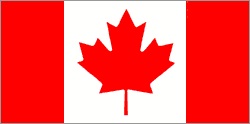The National Flag of Canada
If you travel, you know this flag well: Canadians, anxious to distinguish themselves from their neighbours to the south, brand their clothes and luggage with the red maple leaf. (And plenty of non-Canadians have been known to sport this utterly benign symbol on their backpacks and lapels too.)
The current Canadian flag–an 11-pointed red maple leaf on a white background bracketed by two red bars–was first raised on Parliament Hill in the capital city of Ottawa, Ontario on Feb. 15, 1965.

Previously, the Canadian Red Ensign, featuring a Union Jack and the shield of the royal arms of Canada, had flown over Canada.
The distinctive Maple Leaf flag–officially known as the National Flag of Canada–features Canada’s official colours as designated by King George V in 1921.
According to Canadian Heritage, “the maple leaf was historically used from the early days of Canada to symbolize the land and its people.” (Maple trees are prevalent in eastern Canada.)
It was first proposed as an emblem of Canada in the early 1800s and formed part of the decorations for the visit of the Prince of Wales to Canada in 1860.
It appears as an emblem on the Quebec and Ontario coats of arms (granted in 1868), and on the royal arms of Canada (1921).
The maple leaf was used to identify Canadian military in the two world wars, but didn’t receive official status until the National Flag of Canada was proclaimed by Queen Elizabeth II in 1965.
There is no significance to the 11 points of the stylized leaf that appears on the flag, and there is no official pledge to the flag.
The Canadian flag is sometimes lowered halfway as a sign of national grief; the Government of Canada has a clear set of rules and guidelines around the ritual of “half-masting.”